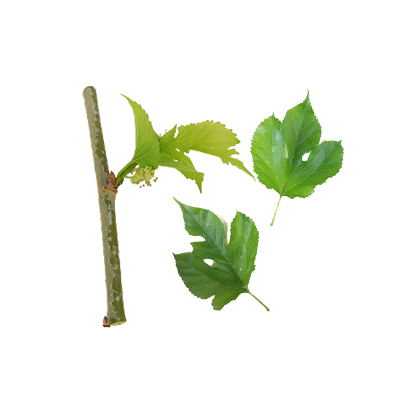Paper Mulberry
Broussonetia papyrifera (L.) L'Hér. ex Vent.
Moraceae
Location in our garden
Orchard



Synonym
Broussonetia billardii Carruth.
Broussonetia cordata Blume
Morus papyrifera L.
Habitus
Shrubs. A deciduous shrub or small tree with a broad, spreading crown; it usually grows up to 9 m tall
Part Used
Leaves
Bark
Sap
Twigs
Growing Requirements
Full Sunshine
Drought Resistant
Habitat
Riverbanks
Forest
Terrestrial
Overview
Native to East Asia and is extensively cultivated within its natural range for its bark. Native to China, Taiwan and Japan and possibly native to the Pacific islands of Hawaii and Samoa. The tree is widely cultivated in temperate to tropical areas of eastern Asia for the fibre in its bark, there are many named varieties. Products made from the fibre are widely sold, especially in the Pacific Islands. The plant is also a very popular herbal remedy in the Orient, provides an edible fruit and has a range of other uses. Broussonetia papyrifera has a very wide distribution, large population, is not currently experiencing any major threats and no significant future threats have been identified. The plant is classified as 'Least Concern' in the IUCN Red List of Threatened Species(2013).
Vernacular Names
Moral de la China (Spanish), Murier a papier (French), Papiermaulbeerbaum (German), Kachnar (India), Gelso papirifero del Giappone (Italian), Aka kowso (Japanese), Gul toot (Pakistan), Lu-a-shu (Taiwanese), Por-gra-saa (Thai), Po'a'aha (Hawaiian).
Agroecology
Broussonetia papyrifera is a very adaptable tree. It is found growing in tropical climates at elevations from sea level to about 2,000 m, but its range also extends well into the temperate zone where mature plants can withstand temperatures down to about -10 °C. It grows best in areas where annual daytime temperatures are within the range of 15 - 28 °C, but can tolerate 500 - 3,000 °C. It prefers a mean annual rainfall in the range of 800 - 2,500 mm, but tolerates 500 - 3,000 mm. Easily cultivated in a warm sunny position in any soil of reasonable quality.
Morphology
- Trunks - medium-sized tree up to 12(–35) m tall, with white latex present in all parts; bole with small buttresses, diameter up to 70 cm, generally gnarled; bark smooth, dark grey, inner bark consisting of tough interlacing fibres that can be extracted in broad layers; crown spreading; branchlets 1.5–3 mm thick, short, soft-hairy.
- Leaves - alternate, simple; stipules up to 20 mm long, membranous, slightly ribbed, caducous; petiole up to 10(–15) cm long, hairy; blade ovate or cordiform or elliptical, 5–20 cm × 4–12 cm, entire or up to 5-lobed, rounded or cordate at base, acuminate to sub-acute at apex, papery, lower surface of young leaves dense soft-hairy, pinnately veined with 5–9 pairs of lateral veins.
- Flowers - unisexual; male flowers sessile, perianth 4-lobed, 1.5–2 mm long, stamens 4, 3–3.5 mm long; female flowers covered by bracts, perianth tubular, 1 mm long, 4-dentate, ovary superior, 0.5 mm long, stigma 1, 7–10 mm long.
- Fruits - an oblongoid drupe, 2–2.5 mm long, 1-seeded, many arranged together in a subglobose infructescence 2–2.5 cm in diameter.
- Seeds - small, 1-2 cm long and wide.
Cultivation
- Propagated by seeds - no pre-treatment is required. Sow in containers, germination usually takes place within 1 - 3 months at 15°c. When large enough to handle, prick the seedlings out into individual pots and grow them on until large enough to plant out.
- By cuttings of half-ripe wood - 8 - 12cm long with a heel, in a frame. High percentage.
- By cuttings of mature wood of the current season's growth, in a frame.
- By root cuttings when the plant is dormant and by layering.
Chemical Constituents
Broussonin A, broussonin B, kazinol F, broussochalcone A, 1-(2,4-dihydroxyphenyl)-3-(4-hydroxyphenyl)-propane, 1-(4-hydroxy-2-methoxyphenyl)-3-(4-hydroxy-3-prenylphenyl)-propane, isolicoflavonol, broussochalcone B, broussoflavonol A and B, broussoflavonol C, D, E, dan F, butyrospermol acetate, erythrinasinate, papyriflavonol A, marmesin, octocosan-l-ol, squalene, 7-hydroxycoumarin, protocatechuate acid, ferulic acid, protocatechuic acid, epicatechin.
Traditional Medicinal Uses
- The leaves are astringent, diuretic. They are used in the treatment of fluxes and gonorrhoea.
- The leaf juice is diaphoretic and laxative - it is also used in the treatment of dysentery. It is also poulticed onto various skin disorders, bites etc.
- The stem bark is diuretic, haemostatic. A decoction is used in the treatment of ascites and menorrhagia. A decoction of the twigs is used in treating eruptions, whilst the juice extracted from them is used in the treatment of anuria.
- The resinous sap found in the bark is used as a vulnerary, and in treating wounds and insect bites.
Part Used
Reference Sources
- Fern, Ken. Useful Tropical Plants. (2021). Broussonetia papyrifera. https://tropical.theferns.info/viewtropical.php?id= Broussonetia+papyrifera. 01-09-21
- Cabi. Broussonetia papyrifera. https://www.cabi.org/isc/datasheet/10017. 01-09-21
- Prota. Plant Resources of Tropical Africa. Broussonetia papyrifera. https://uses.plantnet-project.org/en/Broussonetia_papyrifera_ (PROTA). 01-09-21


